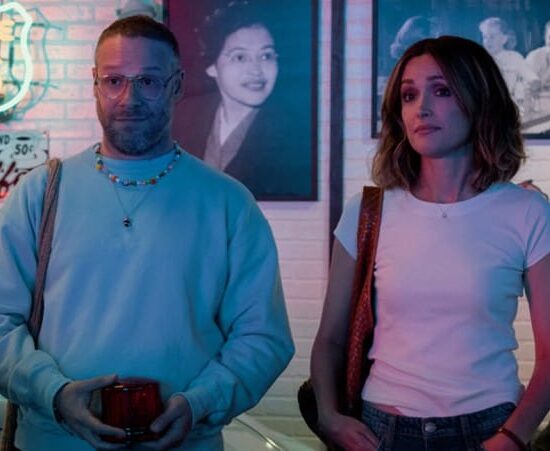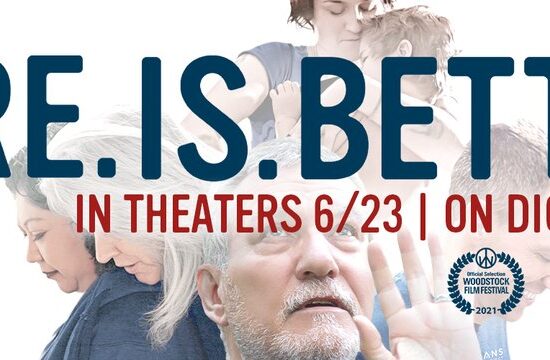
“Right now the system—that’s the sad part of this collapsing system—is basically taking advantage that there are so many filmmakers that are clueless,” Cinema Tropical Co-Founder Carlos A. Gutiérrez shares out loud what everyone knows about distribution and exhibition. The system is broken and opaque, and the consolidation of the market is at an all-time high. The streaming giants are calling the shots, one true-crime show after another, having become de facto studios, distributors and exhibitors all at once—monopolies who decide what everyone watches. Yet, they also fund much of the system, with bigger distributors largely depending on output deals with said streamers.
As much as we’d like to tell an inspiring David-versus-Goliath story about new ventures that resist and win against massive corporations, the reality is much bleaker. “After the top five streamers, the other 130 are just fighting for scraps,” academic Patricia Aufderheide wrote in Documentary about the Amazon-MGM merger. However, facing this reality is the first step toward reinvention.
First off, “Being distributed doesn’t mean being seen,” Brian Newman, former CEO of Tribeca Film Institute, wrote in the Sub-Genre newsletter. Even films that land a major festival premiere or a streaming deal may not find their audiences. Behind closed doors, it is known that even big distributors may buy out theaters on release day to survive the dreaded first-weekend box office. Meanwhile, the majority of filmmakers don’t get anointed by industry gatekeepers, and may not get any distribution deal, spots being finite, even at boutique firms that are more willing to gamble. Filmmakers have to become more imaginative and scrappy to get a piece of the crumbling attention pie, which leaves out people who don’t have the resources or time to market their work. As the “coalition-in-formation” Distribution Advocates is pushing for, we need sustainable, collective and systemic solutions. We have to radically reinvent a broken system. But how?
There is no silver bullet, no one-size-fits-all, and each attempt entails some kind of compromise. As Gutiérrez, also a Distribution Advocates co-founding member, puts it, we need “new and different forms of distribution and exhibition.”
Models based on cooperation and transparency are few and far between. One of the biggest issues filmmakers face is the lack of access to data. OVID.tv, a streaming platform dedicated to documentary film, launched by a coalition of independent distributors, provides a model based on revenue-sharing, where transparency is key. Pooling forces allows them to provide more films—1,600 titles—without paying huge acquisition costs, and contribute greater marketing resources. Industry-wide cooperation is crucial, as they also rely on 46 content partners and their relationships with other distributors. “We share the data at a pretty granular level so [distribution partners] can see how their share was calculated,” Jonathan Miller, who runs the platform, explains. “Another reason for the transparency is, they have to trust us.” While OVID.tv plays an important role in diversifying the kind of films audiences get access to, including “more esoteric or idiosyncratic” work, according to Miller, the biggest amount paid last quarter (May 2022) to a licensor for a film was $450. But the platform is non-exclusive. The challenge remains for filmmakers to find smart ways to split rights and exploit all distribution channels to maximize revenue if they can negotiate that flexibility with bigger distributors, which is not always easy to do, making the need to share information even more crucial to negotiate better contracts.
Transparency is needed also to share how the system works. The Film Collaborative’s Distributor ReportCard, Dear Producer’s Distributors Fact Sheet, and now Distribution Advocates all aim to help bridge the information gap to empower filmmakers.
Models based on cooperation have also been experimented with by worker-owned cooperatives New Day Films and the micro-streaming platform Tënk in France. New Day was launched in 1971; members today pull together resources for production and distribution, sharing coveted mailing lists of educators. Tënk, launched in 2016 in the small French village of Lussas by a group of documentary professionals, grew from a crowdfunded project to a network of 10,000 subscribers-. It is, however, heavily subsidized, and is, therefore, able to provide support to the film ecosystem and to the films it shows on its platform, including those in production.
But most micro-streamers admit that they don’t know how they can survive with the number of subscriptions they currently have.
Major mitigating factors include the lack of regulation, monopolies gaining momentum through the reversal of antitrust laws, and how film production is supported in places such as Latin America or France independently from box office success.
 In the US, which is primarily market-driven, how can smaller companies survive and help filmmakers sustain themselves? Diversifying revenue has worked for the nonprofit Cinema Tropical, which distributes Latin American and US Latinx cinema, and offers programming, distribution and publicity services, on top of relying on a combination of public and private funding. “We were able to build a very flexible format and we act in different capacities,” says Gutiérrez. “For example, sometimes we create packages with programming and then try to sell them as a package to universities, combining programming with educational distribution,”. This hybrid model has allowed Cinema Tropical to remain in business for 21 years. Almost half of their budget comes from publicity services.
In the US, which is primarily market-driven, how can smaller companies survive and help filmmakers sustain themselves? Diversifying revenue has worked for the nonprofit Cinema Tropical, which distributes Latin American and US Latinx cinema, and offers programming, distribution and publicity services, on top of relying on a combination of public and private funding. “We were able to build a very flexible format and we act in different capacities,” says Gutiérrez. “For example, sometimes we create packages with programming and then try to sell them as a package to universities, combining programming with educational distribution,”. This hybrid model has allowed Cinema Tropical to remain in business for 21 years. Almost half of their budget comes from publicity services.
Most importantly, Gutiérrez is creating a model of industry “facilitators,” as he calls them, instead of middlemen. These are entities who are invested in the entire life cycle of a film, not just incentivized to get the biggest cut. “It’s such a fragmented world and basically each film profession has its own agendas,” he notes. “And the fact that we could work as programmers, as publicists, as distributors, gives us a little bit of a space to navigate and to act.”
The nonprofit mobile, solar-powered Sunshine Cinema in South Africa has also been experimenting with diversifying revenue by providing impact training and exhibition services on the continent.
More opportunities for filmmakers to tap into various revenue streams are being developed. The Film Collaborative has for a long time leveraged film festivals as de facto exhibitors, lobbying them to collect screening fees that can become solid revenue for filmmakers.
Virtual cinema initiatives expanded during the pandemic. Kinema was founded in 2020 as a marketplace to connect filmmakers and audiences for in-person and virtual semi-theatrical screenings, which can be a huge revenue stream for filmmakers. The newly launched nonprofit Subject Matter aims to provide support at this crucial juncture of distribution and exhibition for issue-based films while providing matching grants to nonprofits addressing featured causes.
There is also a vital need to rethink the scarcity mindset and program films together, instead of competing. Gutiérrez calls for themed “side-bars” —which rarely happen at film festivals. “Maybe it’s easier to sell them as a 10-film package and to generate more buzz and more press coverage and more attention to those 10 films, than each one separately,” he notes. “But again, that has to do with rethinking our notions of programming, or commercialization. I think the experience for the audience, for everybody, and for the filmmakers themselves is much more enriching.” Indeed, this also allows for a plurality of voices on topics that often get viewed through a colonial lens. All of this cannot happen, however, if we don’t address the crumbling working conditions of the entire ecosystem, from festival programmers to film critics.
“How do you determine another definition of success?” film distribution strategist Mia Bruno asks. “Sometimes it just feels like the emperor’s new clothes; we’re all just looking at the king wearing nothing and just being like, Oh, it looks great.” The “Success?” panel curated by Malikkah Rollins at the DOC NYC 2021 Pro Conference resonated with many because it dared to ask those tough questions. “It’s not a meritocracy. That’s why community is so important,” filmmaker Michèle Stephenson explained. “We’ve been experimenting in silos, we need to collectively re-imagine with different partners at the table and with intentional support to back this labor-intensive ecosystem of distribution, and also supporting audience participation,” she elaborates in a phone call.
Can we imagine an ecosystem where sharing numbers is mandatory? Or can filmmakers demand, collectively, that all players and gatekeepers provide radical transparency?
One solution is finding niche audiences, versus aiming for the mainstream. Relying on and empowering local communities has proved successful for Just Vision and Aflamuna in the Middle East; Sunshine Cinema, and many others. Karin Chien, founder of dGenerate Films and Distribution Advocates co-founding member, has called for the need to revisit regional circuits like Southern Circuit.
Stephano Mendelek explains how the free micro-streaming platform Aflamuna, for Arab audiences by Arab filmmakers, was successfully launched out of the nonprofit Beirut DC, supported mostly by philanthropic funding: “A lot of people in our world right now don’t have credit cards in Lebanon; the banking sector has collapsed. So things like Netflix and Amazon can be extremely inaccessible in the region. Accessibility in general, to Arab audiences, has always been a problem. Local exhibitors won’t necessarily take a chance on independent art cinema.” As the revival of the labor movement across the US shows, collective action is the future. In the nonfiction field, collective advocacy for better labor standards and practices led to the birth of the Documentary Producers Alliance (DPA) in 2016, and a few years later to the Alliance of Documentary Editors (ADE) and its BIPOC Doc Editors database, the Documentary Cinematographers Alliance (DCA), and Documentary Workers United, a union of workers at the International Documentary Association. Organizations such as Brown Girls Doc Mafia, A-Doc, the Undocumented Filmmakers Collective, Firelight Media, Color Congress and others are expanding opportunities for filmmakers of color who have been denied access and power for too long.
Many in the industry have been talking about the need to go beyond an individual version of success. “With American Promise, we built an ecosystem of distribution, but it cost a lot of money,” Stephenson notes. “How [do you] sustain that beyond just one film so other films can tap into that ecosystem that was built?” As more money flows to make a movie rather than distribute it, some also call for a global movement that is both educating audiences and leveraging filmmakers’ collective power.
“If you want an alternative to the big boys and the mega-media companies, then you’ve got to go out and support them.” Miller of OVID.tv explains. “When we started, we thought, well, we need to start a movement. But that’s not realistic. Everybody has their own agenda. We don’t have the resources, we’re not the right people, it’s not our movement.”
Filmmaker Naomi McDougall Jones calls for the equivalent of a farm-to-table movement. “Can we get people out of the psychology of this is a commodity and into the psychology that gets them invested and makes them tip the filmmaker?” she asks. “We’re in the height of this fast-food media era. We need a slow-food media movement, like a mindful media movement.” McDougall Jones and Liz Manashil are also teaming up with fellow filmmakers Elishia K. Constantine and Courtney Hope Thérond to develop a “filmmaker pod,” STORYMADE, which aims to be the new frontier of indie filmmaking: replicable, scalable, ethical, and sustainable. The four filmmaking teams will pool resources to make and distribute films together.
Karin Chien asked in a Getting Real NOW panel in 2020, “Could 500 filmmakers come together, put in a thousand dollars each, and create a year-round staffed distribution company?” She hopes such an initiative could take the marketing burden off of the filmmaker. “If everyone puts a little bit of money in, it creates enough of an annual operating budget, where then you can hire people, so you don’t have to dedicate two years of your life or more to learning how to do that,” she explains on a Zoom call. And if we were to pull money together, Stephenson thinks that “we still need to re-imagine distribution that is subversive; who are we catering to?” She calls for inspiration from the creativity of underground hip-hop, that is directly involving communities, and collectively building more assets around the main film to bring in more audiences, such as the VR monument she’s currently building for her new film in tandem with a local collective.
This is on all of us now to bring forth our collective creativity, exchange knowledge globally, and imagine the world anew.
Nora Poggi is a writer, impact producer, and filmmaker, co-director of the award-winning feature documentary She Started It, and producer of the Creative Distribution 101 podcast.














